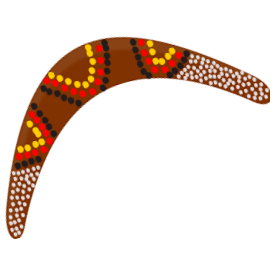Boomerangs – From The Stone Age To The New Millennium
By Connor R Sullivan 2010
Invention
On the list of human inventions, boomerangs happen to be the first heavier than air flying machine. Interestingly, the oldest Australian Aboriginal boomerangs are around ten thousand years old. Some builders and church architects in Australia agree that this concept of making boomerangs is much older than the idea of assisted living design came in to place.
Boomerangs are aerodynamically shaped throwing sticks that date back to ancient times and were found in numerous cultures and civilizations. They have appeared throughout the world including Arizona, Poland, Holland Egypt and certainly Australia. The initial sticks were meant for hunting and they differed in shape from the returning boomerangs. The former were larger and had a shallow angle providing a long and elliptical trajectory.
Development
However, the Australian Aborigines turned them into more accurately angled boomerangs. These are the sticks whose flight path is much curved such that it returns to the thrower. It appears that the tribes used the returning boomerangs for sport rather than hunting. This is the reason why those people developed some unique and exceptional skills both in their making and use.
Boomerangs got the transformation of shape from Australia, but they did not originate from the same place. As mentioned earlier, their historic traces were found everywhere in the world. The problem is that the historians are not sure of the exact origin of the first boomerang. So the latent theory speculates that they were developed from a flattened throwing stick known as the non-returning boomerang. The discovery of the returning boomerang is thought to be an accident by some early hunter trying to fine tune a hunting stick.
Incidentally, this guy belonged to Australia. This is the reason why the modern boomerang is associated with Australia. It has been preserved in the highest standards by the Australian Aborigines. It might also interest you to know that the Australian Aborigines are those groups of people in history who never developed the bow and arrow for their hunting practices.
Modern
The boomerang that we see these days has been refined to quite an extent. Now they are made using the state of the art materials such as paxolin and carbon fiber. The wooden boomerangs are made from the Finnish birch wood that appears to be more durable.
Moreover, the aircraft wind foil design programs and computer aided drawing programs are further employed in order to optimize the flight characteristics. These features make these boomerangs capable of remaining aloft for several minutes and for long distances up to 200 yards.
Summary
To sum it all up, boomerangs do have a recorded history. But the bits and pieces of its background are too scattered that it is difficult to form a comprehensive history. We cannot say for sure if they were developed on purpose or by chance. But one thing is for sure that since the time of their origin, boomerangs have developed to a great extent. They are available in various colors, shapes and sizes. And also employed for the purpose of adventurous sport.
Connor R. Sullivan recently helped his church find a group of knowledgeable church architects to help revitalize the facade of an old church. He hired a local assisted living design firm to help revitalize his ailing mother’s home.
Article Source: https://EzineArticles.com/expert/Connor_R_Sullivan/356498

